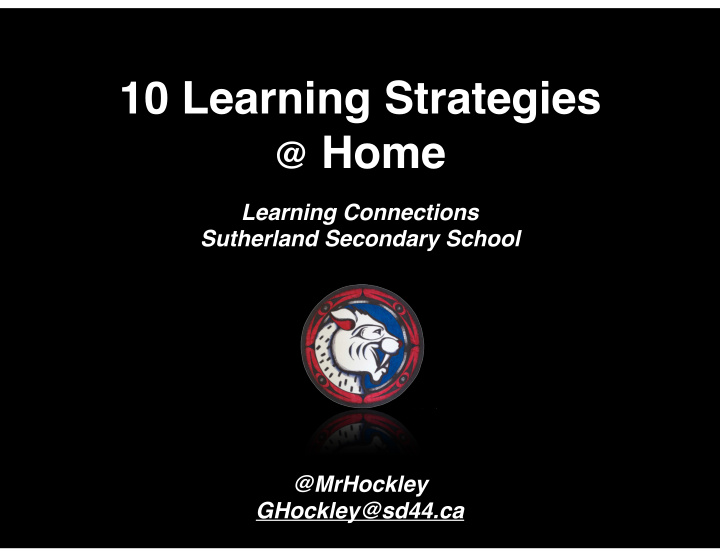



10 Learning Strategies @ Home Learning Connections Sutherland Secondary School @MrHockley GHockley@sd44.ca
Habit an acquired behaviour pattern regularly followed until it has become almost involuntary or automatic
Study Zone Location, Location, Location Functional Workspace Out of High traffic areas Organized, equipped, well lit Comfortable (but not too...) It’s NEVER your bed Personalized
Study Zone Prime Time Find your optimal “prime” time for brain Keep the routine consistent Fixed Length of time e.g.: Mon. after dinner, Tues. after school, Wed after Practice, etc. “No Homework” = review, personal learning, or reading for pleasure
Distraction Free Stopping & Starting upsets Retention, Productivity & Efficiency Smart phones, IM, TV are primary attention distractors Tyranny of the urgent Music
Time Management Start & End with Planning Prioritize Schedule the big things small fill in Always use Agenda / Planner Be strategic of what you do when Quick wins beat procrastination Get to it, be done with it Quality over quantity
Prioritize your tasks
Activate Learning Don’t read or study passively More synapsis = Deeper Learning To activate Take notes Draw Read aloud Teach othe rs
Sketchnoting is a less formal, non-linear method of notetaking. Created by visual learners interested in design, there is a lot of variation in the structure of sketch-notes. For learners who like to doodle, the technique is a way to keep their brain active and still engaged on the topic at hand. Research indicates notetaking like this can improve memory, creativity, and concept understanding, therefore and is often used by innovators and designers.
Persistance Learning is hard work Persistence is the ability to keeping trying to overcome challenges Learning by taking risks & making mistakes Don’t dwell & get frustrated
So take a risk… …and make the jump!
Health & Well-being Body needs to be healthy to learn Nutrition, rest, Happiness, active lifestyle, and balance are crucial Take active breaks during study (20 min. on 5 min. break) Stress is part of life - own it - release it
Sleep Brain research shows sleep is key to teenage health and learning Teenager needs 9 - 10 Hours regularly Sleep routines are vital - weekend can upset Common mistakes: Screen time prior to bed Hyper-stimulates brain Smart phone next to bed interrupts sleep cycle
Support Networks During Study time flag work that will need support - plan to access after Peers, siblings, relatives, tutors Parents may not support with content but can listen & help in other ways School Website and other online resources
Know yourself as a Learner Accept yourself Understand what style learner you are What will work for you and help you learn Know your strengths & your challenges Know your triggers
Positive Approach Brains thrive in positive mindsets Belief in yourself goes along way Routine limits need for nagging Parent vs. Child battles over homework are futile & counter-productive
Curiosity Humans are naturally curious beings Feed your brain by going beyond regular homework & by being curious in areas that interest you When you don’t have work - use the study time to be curious
Successfully changing learning habits is hard and there is much under the surface… Keep working… it’s worth it!
Thank-you! Any Questions? Learning Connections Sutherland Secondary School GHockley@sd44.ca
Recommend
More recommend